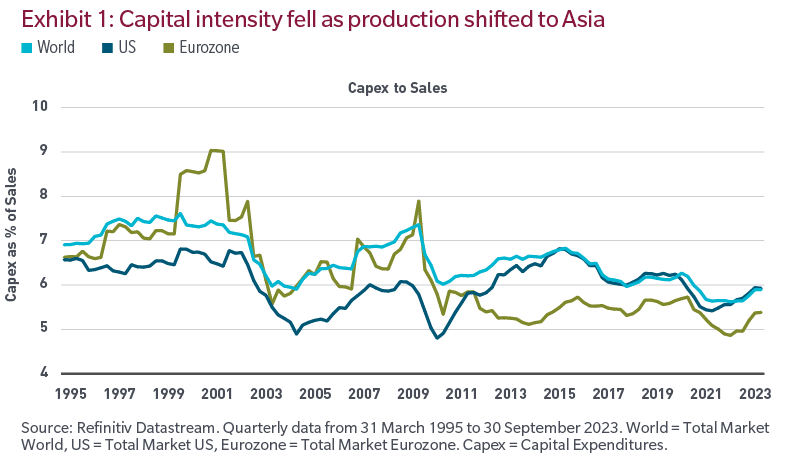This matters because there is a long-term and inverse relationship between capital spending and return on capital. When capital intensity falls, all else equal, returns rise because less capital was deployed. Tangentially, the outsourcing of production also pressured operating expenses due to reduced need for human capital.
The combination of financial leverage by way of artificially-suppressed rates and falling fixed investment drove historic returns for shareholders. But that came at the expense of savers and labor, and exacerbated income inequality. Both trends have ended.
Rising capital intensity is the future
The pandemic, followed by the Russia-Ukraine war, exposed the risk of not having goods available for sale when customers want them. To make a car requires thousands of parts, but it only takes one missing part to halt production. For companies, having a product available on the shelf at a lower margin has become more important than an empty shelf at peak margin. While the building of semiconductor and electric vehicle factories has captured the bulk of the media attention, reshoring and added capacity has extended across electrical goods, chemicals, medical equipment and more. Companies outside of technology and the automotive industry are spending money too.
A brewing cold war between the US and China, and more recently a war in the Middle East, have made this risk even more acute. While the magnitude is uncertain, we can expect deglobalization to divert capital — which in recent years was returned to shareholders via dividends, stock buybacks and acquisitions — to fixed investment. That will likely become a drag on future returns.
Why this matters
While in the short run, trading impulses, such as monthly labor or inflation data, drive asset prices, in the long term, it’s return on capital that matters. Looking ahead, the shift from supply chain efficiency to resiliency will mean that companies that are short of tangible capital will need to make capital investments that will negatively impact returns.
Much like investors, companies are capital allocators. Their stock and bond prices are scorecards, voted on by the market. We’re exiting an environment where the consequences for bad decision-making were blunted by the tailwinds of artificially suppressed rates and globalization. And we’re entering one with a reduced margin for error.
Returns may prove resilient for companies led by great decision makers who understood that COVID-era cheap capital and stretched supply chains were unsustainable. However, companies with high capital needs and elevated debt burdens may disappoint. Since returns drive financial asset prices, this should also bring a paradigm shift in the importance of security selection and active management.
The views expressed are those of the author(s) and are subject to change at any time. These views are for informational purposes only and should not be relied upon as a recommendation to purchase any security or as a solicitation or investment advice. No forecasts can be guaranteed.


